When I was doing research about the Konica FS-1, which is the subject of this post, I read several articles which claimed that the FS-1 was the first 35 mm Single Lens Reflex camera to be fitted with an internal motor drive. That's a claim that I'll return to later in the article.
In the meantime, here is my description and assessment of this camera.
My Konica FS-1 camera
I've had this camera in my vintage camera collection for several years without yet adding it to my camera blog.
This is for similar reasons that I didn't post about the Ricoh AF-5 which I added an article about a couple of days ago, except in the case of the FS-1, I had classified it as Faulty and hadn't got round to fixing it. I remember when I first unpacked it, the battery compartment wouldn't stay attached to the camera body, so I placed it in my 'Faulty - to be looked at' pile, and it was only this week, when I unpacked it from storage and had a closer look, that I realised there are locking sliders that need to be engaged to keep the battery attached!
Once I'd discovered how to keep the battery in place, I checked out the rest of the camera and found that it's basically in good condition. The only negative point is the fact that the leathers are peeling off the front of the camera, but that seems to be a common issue with some makes.
Mechanically, everything seems good, with all the shutter speeds working and the metering looking pretty good. Even the plastic caps on the flash sync and accessory sockets are still in place.
When I bought the camera it was a 'body only' purchase, so for the pictures that follow I've coupled it with the only Konica Lens I have, a 50 mm Hexanon AR, but it does seem to be about the right vintage.
Pictures of the Konica FS-1 camera
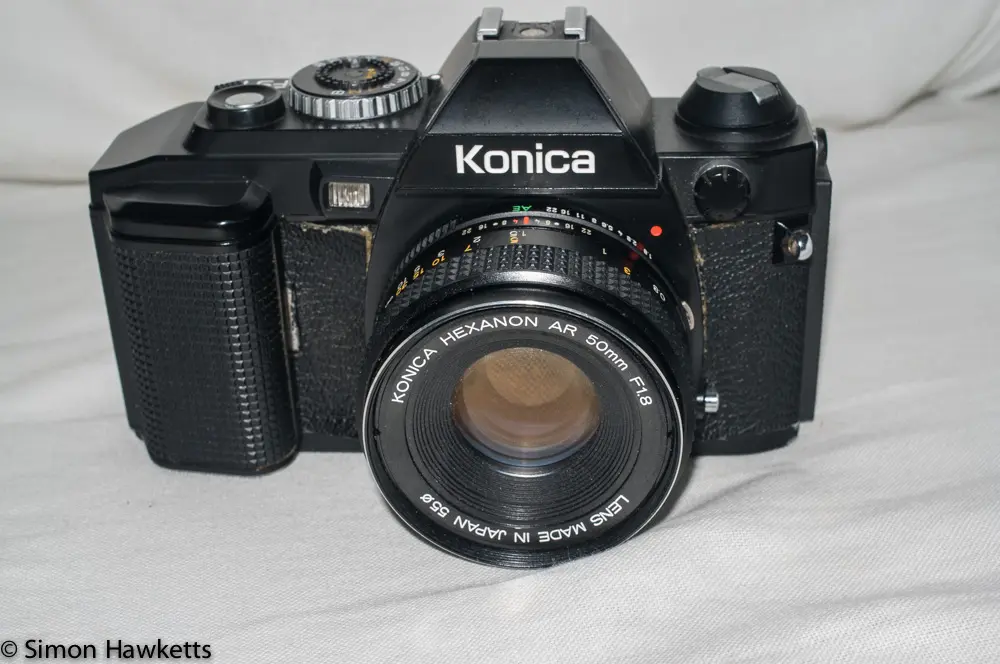
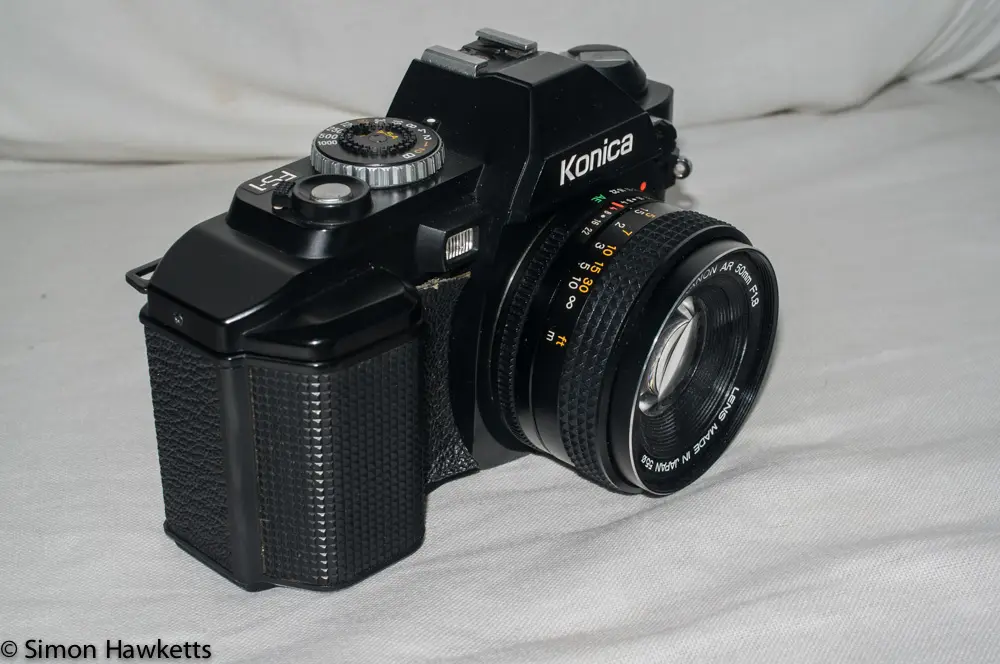
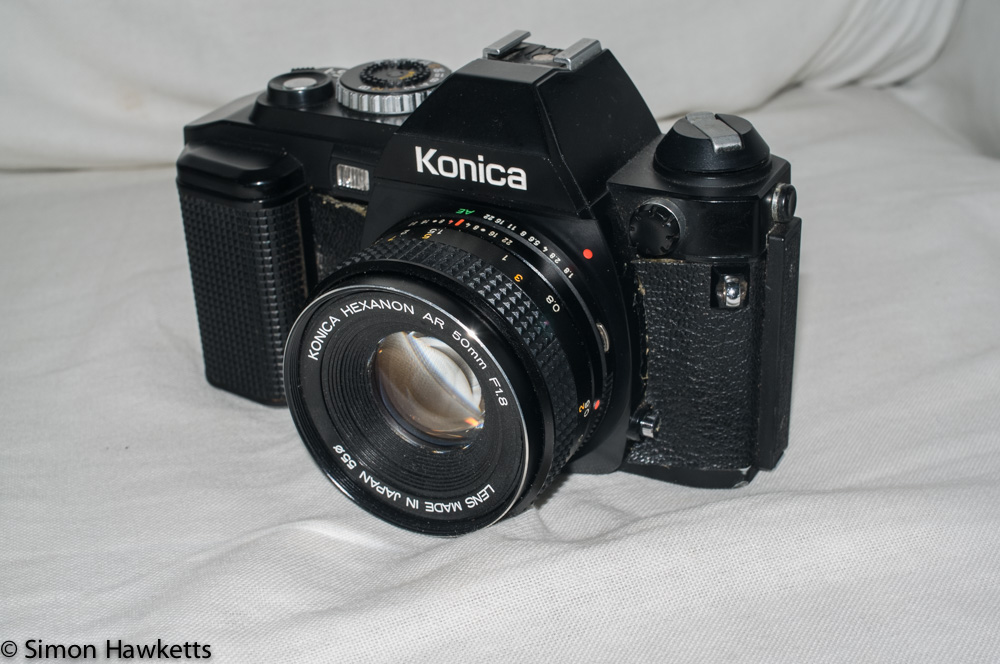


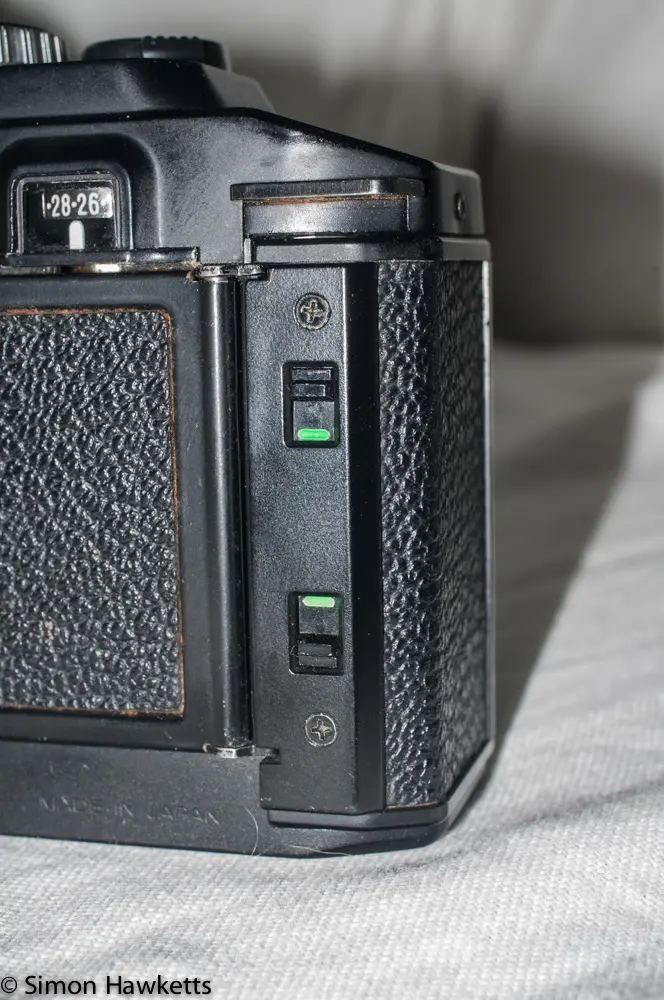
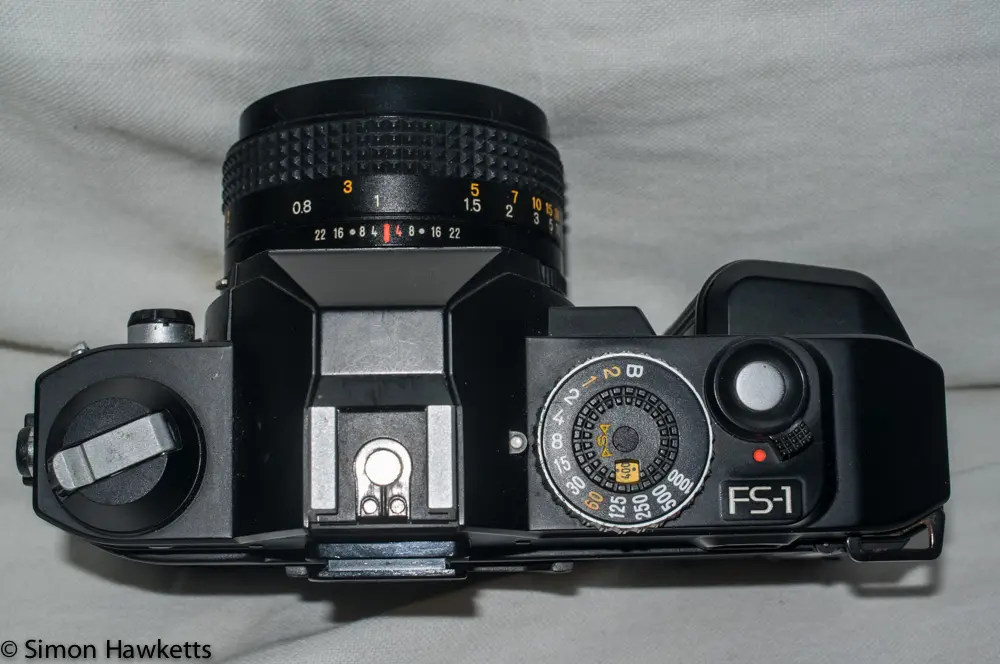
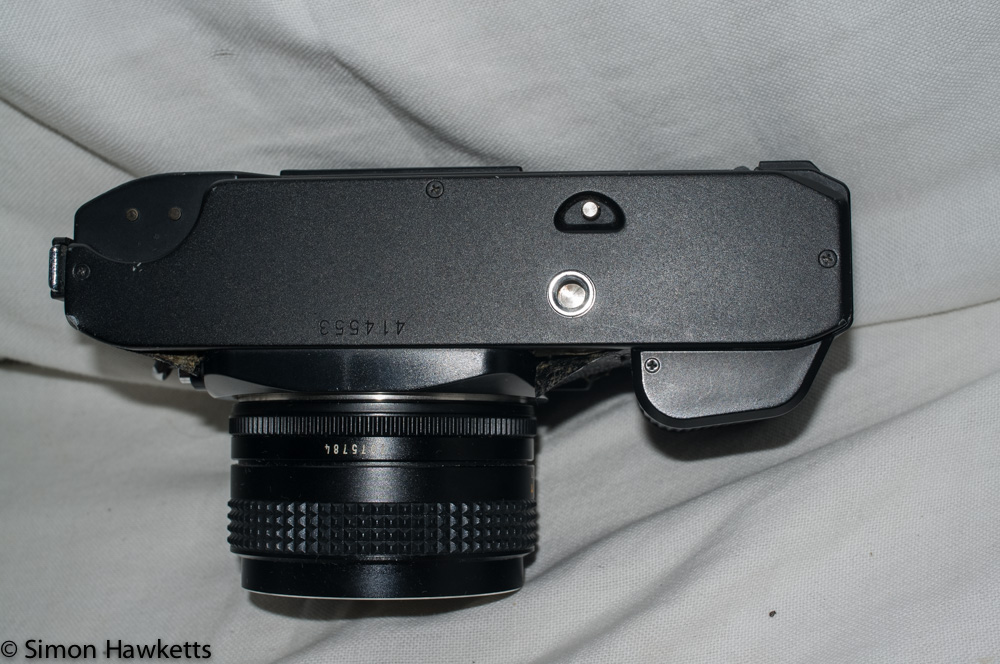
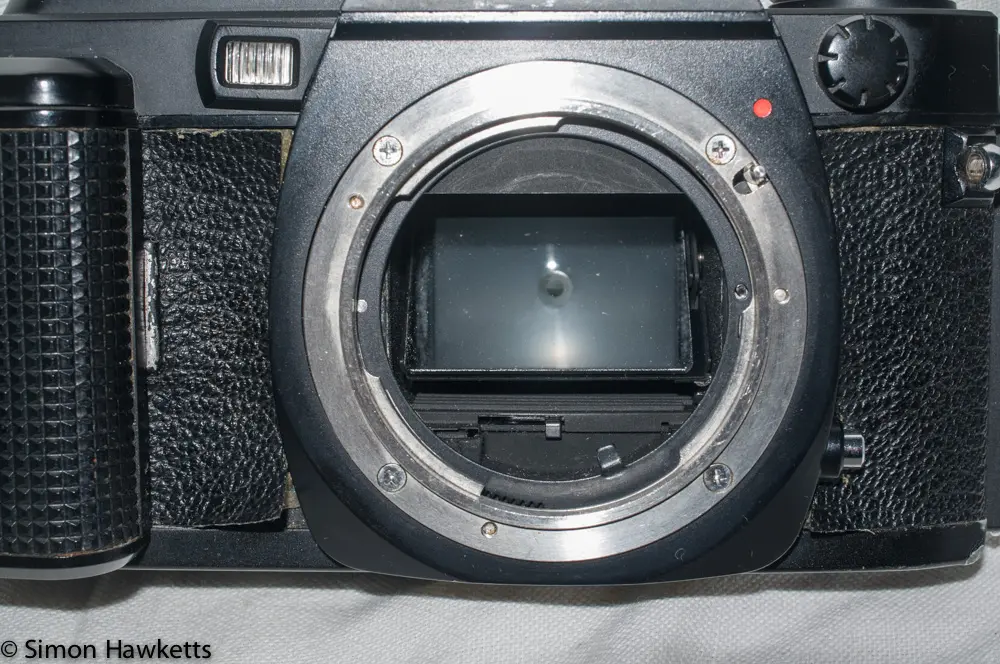
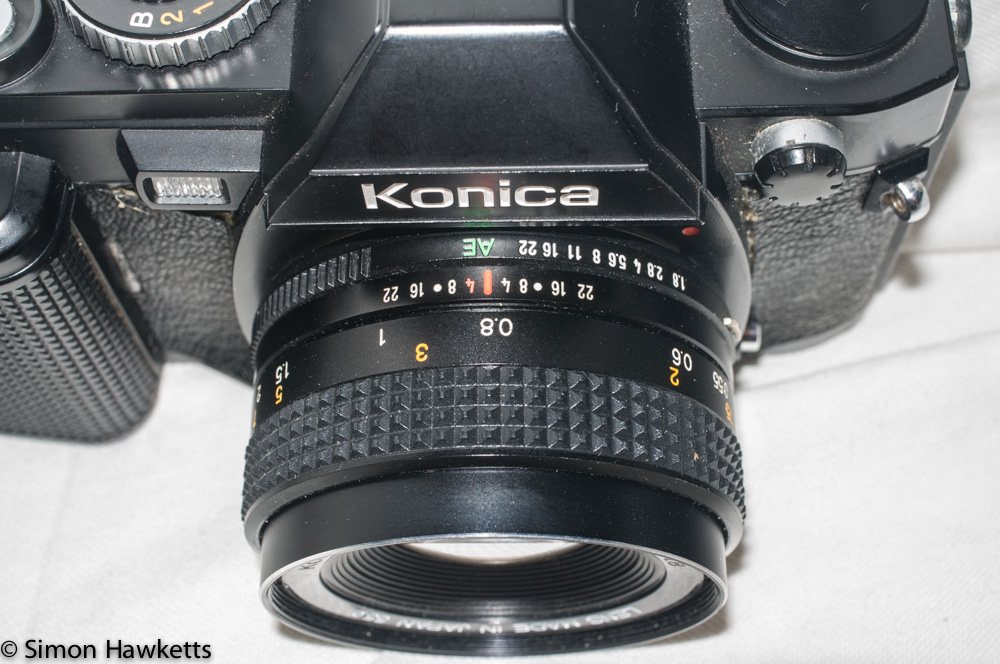

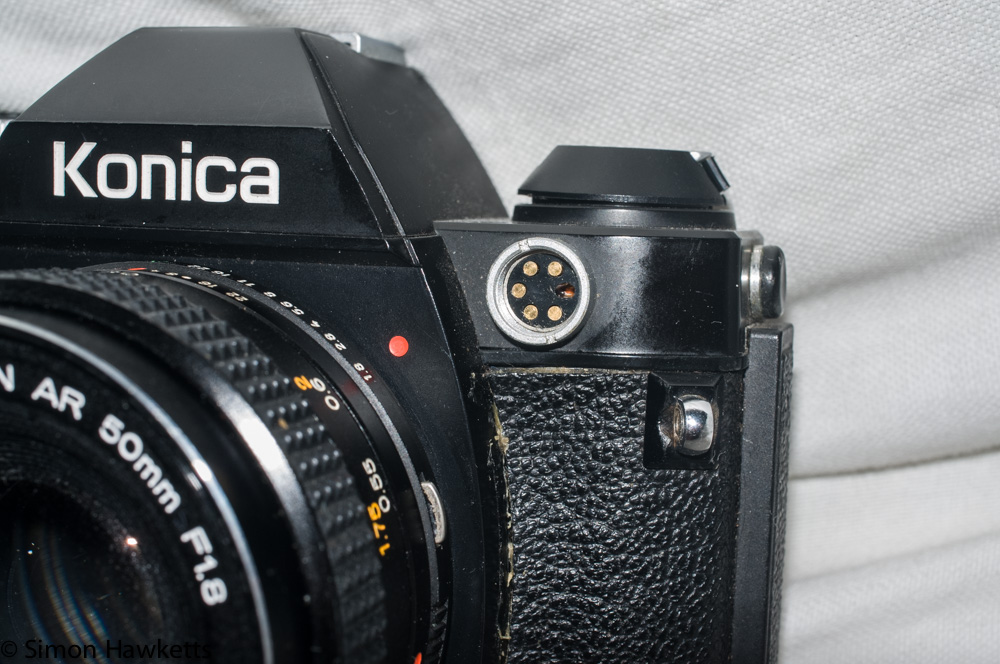
Konica FS-1 Description
The FS-1 is a manual focus, Auto Exposure, Single Lens Reflex which was first made by Konica in about 1979.
Feel and Experience
The camera is quite large and clunky in a typical late 1970s way (typical that is for manufacturers who hadn't followed Olympus down the small, compact camera route that started with the OM-1), but as a result it also feels quite sturdy and dependable. The battery grip forms a deep recession in the front of the camera, which makes holding it very easy - it certainly wouldn't easily slip from your hand.
With the camera held up to your eye, the shutter release and shutter speed dials (the two controls which will need to be adjusted when taking a picture) fall easily to hand, and the viewfinder is bright and informative.
Exposure system
The FS-1 is equipped with an internal, TTL (Through The Lens) light-meter which is used to drive the automatic exposure system when a suitable lens is fitted to the camera. The exposure system is shutter priority, which means that the photographer sets the shutter speed and the camera automatically sets the lens aperture to achieve the correct exposure. To turn on the exposure system, the shutter release button is half pressed, which is a common mechanism for this which is still used in modern cameras.
In order to correctly set the exposure, the camera needs to know the film speed, and this is set using a small dial within the shutter speed dial. I actually find this quite difficult to read, but I suspect this is the result of my aged eyes rather than a poor design.
There is no provision for exposure compensation with the Konica FS-1. If the picture is back-lit or in shadows and compensation is needed, then the recommended solution in the handbook is to either move the film speed dial by up to a stop, or let the camera take a reading and then set the lens aperture up or down to apply compensation.
It is, of course, possible to use the camera in manual exposure mode. To do this, the lens is moved from the AE setting, and the shutter speed and lens set either according to an external light-meter, or the camera itself will give you the correct exposure by indicating in the viewfinder the aperture to set for the shutter speed you have dialled in. If the lens being used is not a Konica AE lens, there is an LED indicator in the viewfinder that will flash when the correct shutter speed / aperture combination is set.
Just for the record, I found adjusting the shutter speed dial whilst holding the shutter release half pressed a very tricky operation which resulted in many accidental shutter actuations.
Focusing the FS-1 and the Viewfinder
The Konica FS-1 is a manual focus camera, so the important thing when it comes to focusing is how easy it is to make sure the photos you take are in focus and sharp. To assist with this aim, the camera has a big and bright viewfinder, along with a split-level focusing aid in the middle.
This helps to achieve focus by producing a split view, similar to some rangefinder cameras, where the scene is split across the centre and as the subject comes into focus the two split areas converge to give a normal view. This was a common feature in many manual focus SLR cameras in the 1970s, and it was so successful that Fuji made an electronic version for their X-T1 mirrorless camera.
As well as the split-level focusing aid, there is also a micro-prism circle around the centre portion of the viewfinder, which exacerbates the de-focus and therefore also make focusing easier.
The picture shown here is my (not terribly good) attempt to capture the view through the viewfinder of the Konica FS-1 using my mobile phone camera. Although it's not ideal, it does at least give an indication of the view.
Basically, there is a scale down the left-hand side which shows the aperture the camera has selected for the shutter speed chosen. Unfortunately, it's almost impossible to see the split image display in the centre of the screen in this photo, but I assure you it's there! You do get an impression of how big and bright the viewfinder is, however.
Other camera features of the Konica FS-1
There are many features of the Konica FS-1 that are fairly standard for a camera of this era, like a self-timer, hot shoe flash sync, auto reset frame counter and a useful holder on the back panel that takes the cardboard top of the film packet to remind you of the film that's been loaded into the camera.

There are also a couple of features that are not standard and make the FS-1 stand out a bit from the crowd.
The first is the accessory socket which is fitted on the top of the camera front under the rewind crank. This allowed a variety of different accessories to be plugged into the camera to extend its functionality.
There were some really quite interesting accessories made, which are listed in the manual. The things that caught my eye were:
- A left-hand release switch, so the camera becomes easier to use left-handed.
- An interval timer accessory to set up taking regular images at a fixed interval.
- A radio control unit that allows the camera to be fired remotely by radio
There were also standard things like cable releases that were very long, which was possible because they operated electronically rather than mechanically.
The other unusual feature was the internal motor drive that powered the film transport. As I said at the start of this article, I'd seen several claims that the Konica FS-1 was the first SLR camera to be fitted with a motor drive, so I tried to find out if this was a valid claim.
I found this Wikipedia article on the Motor Drive which doesn't specifically say the FS-1 was the first SLR with internal motor drive, although it does have a picture of the camera in the sidebar of the article. With a bit more research I found a more comprehensive article on camera history here, which actually states that the first camera with an external motor drive was the Nikon F in 1959, and then, later lists the Konica FS-1 as the first SLR camera with inbuilt motor autoload.
So I believe the claim to fame that this camera has is that it was one of the first to have internal motor drive and the first with film autoload.
Konica FS-1 Specifications
- Konica FS-1 Manual focus SLR camera
- Manufactured in about 1979
- Split image focusing + micro prism
- Through the lens metering system
- Film speeds of ASA 25 to ASA 3200
- Konica Bayonet mount lens
- Internal Power winder with up to 1.5 frames per second when held
- Metal vertical focal plane shutter
- Shutter speeds 2 sec to 1/1000 sec + bulb
- Electronic self-timer of 10 sec
- Shutter priority Auto Exposure or Full Manual control
- Exposure information available in the viewfinder
- Powered by 4 AA batteries in the grip
- Hot Shoe and Flash Sync socket
- Accessory socket allows various different control options
- Serial No: 414553
- Manual available on-line here
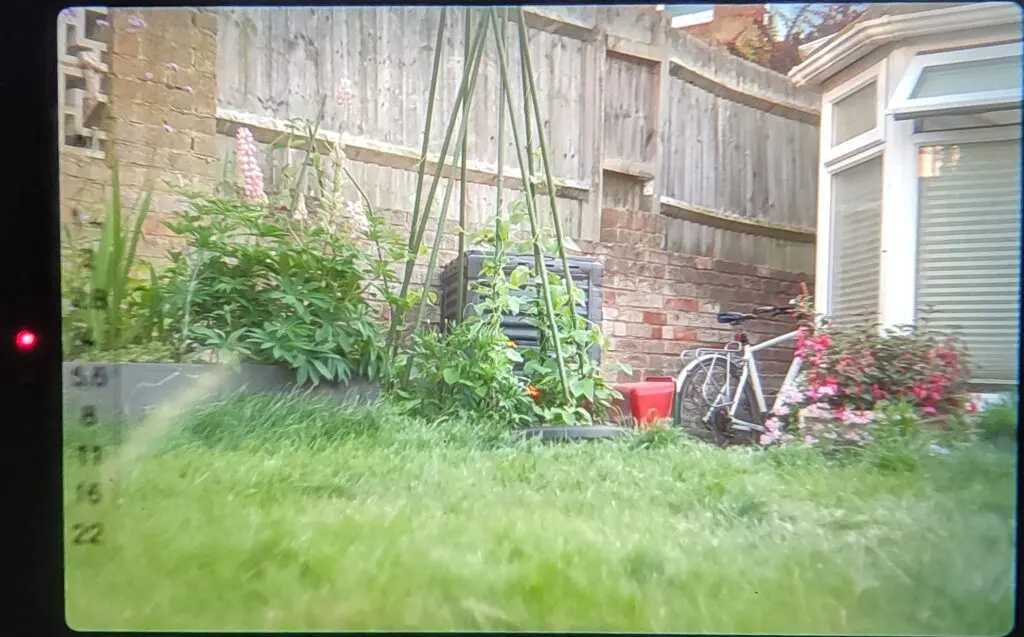

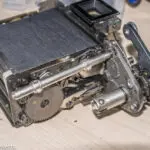
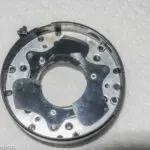
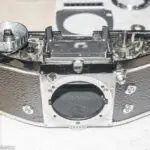
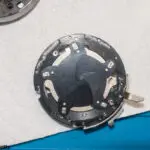

Hi. Just a quick comment on your excellent review of the FS-1. It wasn’t anything like the first camera with an integral motor drive. That goes way back to a French camera called Le Pascal in about 1899, continued though the Debrie Sept in 1922 and was most famous for the motor driven Robot cameras from 1934 onwards. All of these, however, were clockwork driven. The GS-1 was the first with an ELECTRIC motor drive built in, and I can say that with some certainty because I was at the press conference when it was launched.